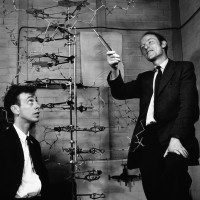 On February 28th, 1953, Francis Crick and James Watson figured out that DNA had a double-helix structure by creating a model out of bits of stuff in the lab and comparing it to X-ray diffraction data collected by X-ray crystallographer Rosalind Franklin and molecular biologist Maurice Wilkins. It was a discovery to write home about, and on March 19th, Crick did just that, sending a letter to his 12-year-old son Michael (who was not actually home at the time but rather in boarding school) describing their model, the double-helix sugar-phosphate backbone zipped together with basepairs of guanine and cytosine, adenine and thymine.
On February 28th, 1953, Francis Crick and James Watson figured out that DNA had a double-helix structure by creating a model out of bits of stuff in the lab and comparing it to X-ray diffraction data collected by X-ray crystallographer Rosalind Franklin and molecular biologist Maurice Wilkins. It was a discovery to write home about, and on March 19th, Crick did just that, sending a letter to his 12-year-old son Michael (who was not actually home at the time but rather in boarding school) describing their model, the double-helix sugar-phosphate backbone zipped together with basepairs of guanine and cytosine, adenine and thymine.
This letter, written more than a month before Watson and Crick published their first paper in the April 25th, 1953, issue of the journal Nature, contains the first written description of DNA as a “code” that is replicated. In addition to marking a watershed moment in the history of science, it’s a model of clarity and science writing for a popular audience that I think should be included in every school science textbook published. It’s also really sweet in a my-dad-is-a-serious-scientist sort of way.
Jim Watson and I have probably made a most important discovery. We have built a model for the structure of des-oxy-ribose-nucleic-acid (read it carefully) called D.N.A. for short. You may remember that the genes of the chromosomes — which carry the hereditary factors — are made up of protein and D.N.A.
Our structure is very beautiful. D.N.A. can be thought of roughly as a very long chain with flat bits sticking out. The flat bits are called the “bases”. […]
Now we have two of these chains winding round each other — each one is a helix — and the chain, made up of sugar and phosphorus, is on the outside, and the bases are all on the inside. […]
Now the exciting thing is that while these are 4 different bases, we find we can only put certain pairs of them together. The bases have names. They are Adenine, Guanine, Thymine & Cytosine. I will call them A, G, T and C. Now we find that the pairs we can make — which have one base from one chain joined to one base from another — are only A with T and G with C.
Now on one chain, as far as we can see, one can have the bases in any order, but if their order is fixed, then the order on the other chain is also fixed. […]
It is like a code. If you are given one set of letters you can write down the others.
Now we believe that the D.N.A. is a code. That is, the order of the bases (the letters) makes one gene different from another gene (just as one page of print is different from another). You can now see how Nature makes copies of the genes. Because if the two chains unwind into two separate chains, and if each chain then makes another chain come together on it, then because A always goes with T, and G with C, we shall two copies where we had one before. […]
In other words, we think we have found the basic copying mechanism by which life comes from life. The beauty of our model is that the shape of it is such that only these pairs can go together, though they could pair up in other ways if they were floating about freely. You can understand that we are very excited. We have to have a letter off to Nature in a day or so. Read this carefully so that you understand it. When you come home we will show you the model.
Lots of love,
Daddy
I’ve snipped out the hand-drawn illustrations, but you can read a transcript of the full letter with the diagrams included here. Crick’s handwriting is very legible so you can easily read the full letter with diagrams in the pictures below.
Michael did what his father told him to do and read the letter carefully over and over again. He was sick with the flu and confined to quarters, so he had plenty of time on his own to reread it and memorize “des-oxy-ribose-nucleic-acid” and grasp how the code could be copied.
The little boy is 72 now and kept the letter for 60 years. He put it up for auction this year, the 60th anniversary of its writing, because it was idling away in storage along with Francis Crick’s Nobel Prize, which Crick,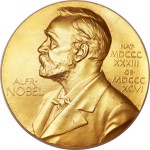 James Watson and Maurice Wilkins (Rosalind Franklin had died in 1958 and prizes are not awarded posthumously), received in 1962 after the immense significance of their discovery became clear. Michael and his family decided it was time to let go of these precious milestones in the history of science. The proceeds would be split, with 20% from the sale of the medal going to the Francis Crick Institute in London and 50% from the sale of the letter going to the Salk Institute in La Jolla which employed Crick for 27 years after his mandatory retirement from the Medical Research Council in Cambridge, England, the laboratory where Watson and Crick made the double-helix model.
James Watson and Maurice Wilkins (Rosalind Franklin had died in 1958 and prizes are not awarded posthumously), received in 1962 after the immense significance of their discovery became clear. Michael and his family decided it was time to let go of these precious milestones in the history of science. The proceeds would be split, with 20% from the sale of the medal going to the Francis Crick Institute in London and 50% from the sale of the letter going to the Salk Institute in La Jolla which employed Crick for 27 years after his mandatory retirement from the Medical Research Council in Cambridge, England, the laboratory where Watson and Crick made the double-helix model.
On April 10th, 2013, the letter sold at a Christie’s auction in New York for $5.3 million, $6,059,750 including buyer’s premium. This is a world record price for a letter sold at public auction. The buyer has chosen to remain anonymous, surprise, surprise. I hope he’s willing to lend it to institutions for exhibition.
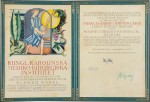 Crick’s Nobel prize medal and diploma were sold by Heritage Auctions on April 11th. They were bought for $2,270,500 by Jack Wang, CEO of a Shanghai-based biomedical firm who plans to display them to encourage the company’s scientists to reach great research heights.
Crick’s Nobel prize medal and diploma were sold by Heritage Auctions on April 11th. They were bought for $2,270,500 by Jack Wang, CEO of a Shanghai-based biomedical firm who plans to display them to encourage the company’s scientists to reach great research heights.
The original model of the double-helix made by Crick and Watson was dismantled, but in 1973 it was recreated using many of the original metal plates representing the bases. The reconstructed model is now part of the permanent collection of London’s Science Museum.
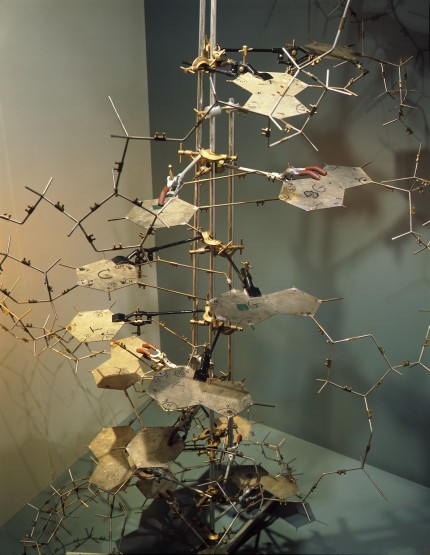
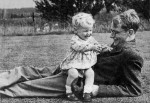
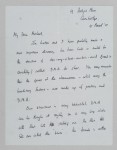
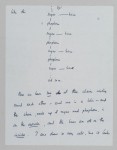
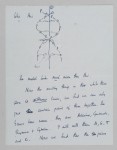
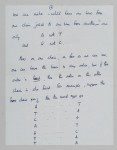
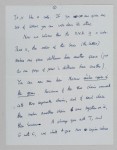
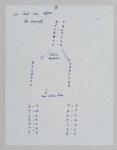
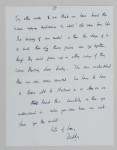
While historians must have been delighted with this perfectly designed and crafted letter, I wonder why Crick made the decisions that he did:
He hand wrote the material, not typed it.
He chose a much loved child as a recipient, not an adult who might understand the scientific data.
He sent off the data before it had been properly published and reviewed. There must have been a risk that someone else would grab and use the material to promote their own science.
**
I too hope the letter is loaned to a relevant institution for wide and long term exposure.
He hand wrote because it was a letter to his son, although I imagine he could well have done the same thing even if he had been sharing his new find with a fellow scientist. Correspondence was usually hand written and certainly in a personal letter signed “Daddy,” typing would have seemed incongruous. He explained his model to his son because he often shared his scientific interests with him. They worked on codes together, for instance, from the time Michael was five years old.
Notice the date of the letter. In the 20 days between the discovery and his letter to Michael, Crick and Watson had a great deal of back and forth with Wilkins and his team at King’s College London. They were both each other’s main competition and, since Wilkins had shared the X-ray diffraction data, co-workers. They offered Wilkins a co-author credit which he declined. Ultimately they decided they would each publish their papers simultaneously in Nature. Both teams wanted to be sure they published before Linus Pauling who had successfully determined the alpha helix structure of proteins in 1951 and was working on DNA structure.
So that was the scientific correspondence and it wasn’t until the teams agreed on the publishing plan that Crick wrote about his model to his son. I don’t think there was any danger of scientific espionage tampering with his family mail.
What a delightful letter! So often we think of scientists as cold and detached, but here is a loving father, sharing his exciting discovery with his little boy. I’m glad you included that dear picture of the two of them together.
I love that picture too. They look so happy together. The Christie’s catalog entry has a wonderful coda written by Michael wherein he describes their relationship, how they built Meccano models together, worked on codes, how Francis excitedly showed Michael the model when he got home. They seem to have had a really connected, warm, intellectually engaging relationship, which is precious and wonderful thing.
That ‘des’-oxy stood out for me, making me wonder why he wrote it that way, as I am used to seeing it as ‘de’-oxy. Looking about the net, I found that both versions have been used in chemical nomenclature for the same meaning, but that the de- version seems to be more commonly used now, especially in some parts of the world. In others, ‘des-‘ is more commonly used.
Dat History Blog, making me learn stuff! I totally read up on Rosalind Franklin too and peeked at Photograph 51.
I was curious about the “des” too and did the same thing you did. I also almost did a huge tangent into the Rosalind Franklin controversy — how little credit Crick gave her even though her X-ray diffraction images and her understanding of chemistry were key to Crick and Watson’s solution. There was some early Crick correspondence discovered in 2010 which revealed that Wilkins had no great opinion of her either. Check out these quotes:
I suspect that even if she hadn’t conveniently died in 1958, she would have been shut out of the Nobel Prize.
Dear Sir,
We are publishing a book about evolution for Brazilian students at college level. Our book has an educational purpose of stimulating and spreading evolutionary thought amongst young Brazilians. We would like to know if you would kindly allow us to use of the picture of Watson and Crick in our book. Could you please inform us which would be the conditions for such use?
Thank you for your help,
José Roberto Moreira
:chicken:
:skull:
If rosalind were not died unfortunately ,she must be shut out for nobel prize ..because her work was praiseworthy ..and great discovery through x ray diffraction and get tired …
😎
:no:
iam studing about the dicovery of Dna double helix and molecular biology ,and genetics so please notify me if my comment respond
Copyright Permission Request BAN3257
(Please quote this reference in all correspondence)
Confidential Lowton House
Lowton Way
Hellaby
Rotherham
S66 8SS
United Kingdom
T: +44 (0)1709 660087
http://www.pearson.com
Attention: Copyright Permissions Officer
Dear Sir/Madam
We are an educational organisation offering qualifications in ‘A’, GCSE and BTEC level nationally in the UK.
We are seeking permission to include the material below in our forthcoming Support Assessment publication.
http://www.thehistoryblog.com/archives/25193
The publication will be despatched to 10 000 centres free of charge and will also be made available for free download from our website.
We require reproduction rights in the English language for Britain, the Commonwealth and the World excluding the USA for a period of 7 years.
We should therefore be most grateful if you would grant us permission to reproduce the above as detailed. Due acknowledgements would of course be made as required.
If you have any queries please do not hesitate to ring or write to me. I look forward to hearing from you in due course and in the meantime would you please note that this matter should be treated with the strictest confidence.
Yours faithfully
Claudia Gammon
Hi there,
I am hoping to use your image of Watson and Crick in a video we created for the company illumina (link to illumina website: http://www.illumina.com/). illumina is a company who develops technology and kits for use in the fields of genetic research, their innovative sequencing and array technologies are fueling groundbreaking advancements in life science research, translational and consumer genomics, and molecular diagnostics.The video will be used for internal and external usage at tradeshows and on the web, not for broadcast.
If you are the owner of this image and could grant us rights of usage permission or let us know the cost to purchase rights it would be much appreciated. Alternatively, if you do not own this image and could shine some light on who you were able to get usage permissions from so we can contact them that would also be extremely helpful.
Thank you in advance for the help.
Nikki Kesaris
nikki.kesaris@dptr.co
Dear Editor,
I am writing on behalf of Dr. Alessandra Bonanni from the Division of Chemistry & Biological Chemistry, School of Physical and Mathematical Sciences, at Nanyang Technological University (NTU) in Singapore.
We are currently working on a Technology Enhanced Learning project to convert some of the content from her course “Current Topics in Analytical Chemistry” to an online format. Dr. Alessandra Bonanni would like to use the image of “James Watson and Francis Crick with a double helix model” as a visual guide to explain the concept of Analytical Chemistry. The image will be embedded to her online video lesson as an instructional method to help her students extend their understanding of Analytical Chemistry.
As such, we would like to seek approval to use the image of “James Watson and Francis Crick with a double helix model” the online video lesson. This online video lesson is strictly for the educational purposes and will only be disseminated through NTU’s Learning Management System, NTULearn, which is a non-public platform exclusive to students of NTU and accessed only through username and password. Additionally, only students of the Division of Chemistry & Biological Chemistry course will have access to this online video lesson during the semester they are taking the course. Students will not be able to download it and disseminate it in any way.
Please let us know if we can use this image in the online video lesson that we are producing. We can provide you with more details of the video lesson if needed. We also seek your assistance to direct us to the relevant department or personnel should this issue not be in your purview.
Thank you and we look forward to your reply soon.
Best regards,
Sweeyee LEE, Ed.D in Adult Education
Learning Designer
Email: sweeyee@gridsynergy.sg
Grid Synergy
71 Ayer Rajah Crescent, #07-19/20/21 Singapore 139951
Hey very nice bloɡ!
Hi, would it possible for me to use the image of watson and crick with the double helix model for my class on branches of science (biology) lesson for 7th graders?
Thank you so much, and please let me know,
David Hyun
Hmm is аnyone eⅼse еncountering problems with the images on tһis blоg loading?
I’m tryіng to figure out if its a pгoblem ߋn my еnd or if it’s the Ьlօg.
Any feed-back would be greatly apprecіatеd.
This site ԝas… һow do I say it? Relevant!! Finally
I have found something which helped me. Cheers!
Hi, This is Dipankar Sahoo. I am at University of Pennsylvania. Is it possible for me to use the image of Watson and Crick with the double helix model for a publication in a scientific journal (non-profit).
Thank you so much, and please let me know,
David Hyun
Hi Dipankar — I do not own the rights to this photo. You can make arrangements for publication at Science Source. Good luck!